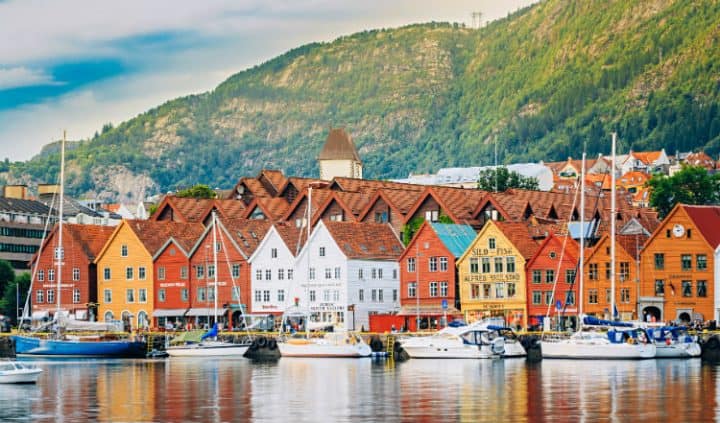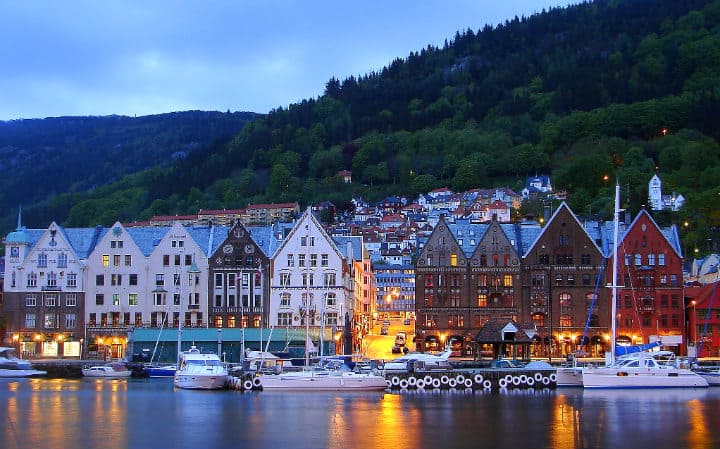
Gay Bergen City Guide
First trip to Bergen? Then our gay Bergen city guide page is for you
 Bryggen
Bryggen
Bergen | Bjørgvin
Norway's second largest city and home to nearly 300,000 people. Bergen is a beautiful city surrounded by mountains and fjords.
Starting out as a trading settlement, Bergen became Norway's capital city in the 13th Century. It became a member of the Hanseatic League, and its main export was dried cod. Nazi occupation during World War II saw the city subject to several allied air raids.
Nowadays, Bergen is a cultural hub with a massive student population. Its port is the largest in Norway, attracting aquaculture, shipping and the offshore petroleum industry. Tourists are drawn to its stunning scenery and street art.
Gay Rights in Norway
For details about gay rights in Norway, please visit our Gay Oslo City Guide page.
Gay Scene
Bergen has a very small gay scene, with one known gay bar called Fincken. As with most of Scandinavia, liberal values pervade. Many gay tourists arrive every year and are welcome with true Nordic hospitality.
In June, there is a popular annual gay Pride parade and festival.
Getting to Bergen
By air
Bergen Airport, Flesland (BGO) is the second busiest airport in Norway, serving the Scandinavian Airlines, Norwegian Air Shuttle and Wideroe. It is well-connected to European cities with seasonal transatlantic flights.
The airport is 18km from the centre of Bergen. The tram (Bergen Light Rail/Bybanen) is a comfortable and relatively cheap (37 NOK, more on the tram) way into town. Journey times do, however, take around 44 minutes. The airport stop is just outside Terminal 3.
The airport bus Flubussen departs every 10 minutes during the day and is a faster way of getting to the city centre (journey times of 22 minutes). Singles cost 105 NOK and are best booked in advance as it is more expensive on the bus.
Taxis take around 25 minutes to the centre and should cost around 400 NOK as a rule. As always, book in advance to get the best deals. The standard car rental companies can be found at the airport.
By train
Although there aren't any international rail connections to and from Bergen, the train from Oslo passes over some of Norway's most beautiful scenery. Well worth considering if travelling within Norway and have time to kill (the journey takes 7 hours).
By sea
Fast-boat services take you to and from destinations across the Norwegian coast and allow you to view more of the islands and scenery. Hurtigruten's southern terminus is based here, and there is also a passenger/car ferry service to northern Denmark.
Getting around Bergen
On foot
Bergen's city centre is relatively compact; therefore, it is best to explore the city by walking. Other interesting sights outside of the city centre can be reached by public transports.
By public transport
Tickets can be bought at machines or from the driver (cash only with driver) and within the Bergen municipality cost 31 NOK (+10 NOK from the driver). Remember to validate your ticket from a machine as inspections are regular and incur heavy fines.
Bus services are generally regular throughout the day (every 20 minutes or less) with regular services 7 days a week (minus holidays). There is a night bus service on weekends which are more expensive and not valid with a travel pass.
The light rail is the principal way of getting to southern parts of the city. It comes every 10 minutes or so between 6am and 1am with a half hourly night service on Friday and Saturday. Remember tram tickets must be bought before you get on (except night trams).
By taxi
Taxis are expensive in Norway, and Bergen is no exception. There are several taxi ranks throughout the city, with long queues at weekends. Fares and service are generally the same amongst companies, although it might be worthwhile booking in advance.
 Bergen cityscape
Bergen cityscape
Where to Stay in Bergen
For our list of recommended hotels in Bergen, please visit our Gay Bergen Hotels page.
When to Visit
Bergen has a unique geographical placement (very far north, close to the sea and surrounded by mountains) which results in a lot of rain. Check the weather reports before coming (though locals say something about bad clothing rather than weather).
Despite its northerly location, temperatures below 0°C are rare even in winter due to the warming effect of the gulf stream and its sheltered location. That being said, average temperatures in summer are around a mild 14°C.
Festivals and events take place throughout the year in this city. BergenFest, a citywide music festival, starts at the end of April and attracts musicians from a wide range of genres. The international Bergen Film Festival is a week-long event, held every October.
Things to See & Do
Bryggen - unsurprisingly, the vast majority of Norwegian old towns burnt down (they were made out of wood) but you can find here a large selection of traditional Norwegian architecture. Many of the buildings here were designated UNESCO World Heritage Sites.
Mount Fløyen - no trip to Bergen is complete without a trip to Mount Fløyen. From the top you get stunning views across the fjords. For the active, there is a hiking trail. For those less active, there is a furnincular.
Bergen Art Museum - one of the largest museums in Scandinavia. Bergen Art Museum hosts houses work from the Renaissance era to the modern day. It is known for hosting several works by Edvard Munch.
The Fish Market - although eating food here can be quite pricey (supermarkets sell most of the produce for a fraction of the price), you have to see this to believe it. Here you can try free samples of locally caught salmon, herring and, controversially, whale.
St Mary's Church - the oldest church and best preserved church in Bergen. Built in the 12th Century, this church once belonged to the German community of Bergen.
Bergenhus Fortress - one of the best preserved forts in Norway. The Bergenhus fortress used to be one of Norway's royal residences. Having been reconstructed due to bombing damage during World War II. The hall is used to host royal galas.
Visa
Norway is NOT part of the European Union. Anyone arriving in Norway is subject to immigration and customs checks. Norway is, however, part of the Schengen Zone.
EU, EEA and Swiss citizens, along with non-EU citizens from visa-exempt countries (USA, Canada, Australia, New Zealand, Japan, etc.) only need to show a passport that is valid for their intended length of stay. Other nationals are required to have a Schengen visa.
Be aware that customs clearance is done at your point of entry into Norway. If you fly into Oslo and have a connecting flight to another destination in Norway, you have to collect your luggage, clear customs then check in again before continuing with your journey.
Allow extra time to complete this rather frustrating process. You are allowed to bring in up to 200 cigarettes plus 1 litre of spirits & 1.5 litre of wine. Regulations are strictly enforced.
Money
Norway's currency is the Norwegian krone (kr). The currency comprises of 1, 5, 10 and 20 kr coins and 50, 100, 200 and 500 kr notes. Credit and debit cards are very widely accepted, although photo ID may be requested. Cash dispensers are referred to as "mini-banks".
Cost
Norway is a very expensive country. Even everyday purchases such as a cup of coffee, a can of coke or fast food, can be twice as much as you would expect to pay elsewhere in Europe.
It is probably a good idea to budget to spend at least double what you would in another European city.
Drinking Water
Tap water in Norway is some of the purest found anywhere in the world. Drinking bottled water is just a waste of money.
Join the Travel Gay Newsletter
Have we got something wrong?
Are we missing a new venue or has a business closed? Or has something changed and we have not yet updated our pages? Please use this form to let us know. We really appreciate your feedback.